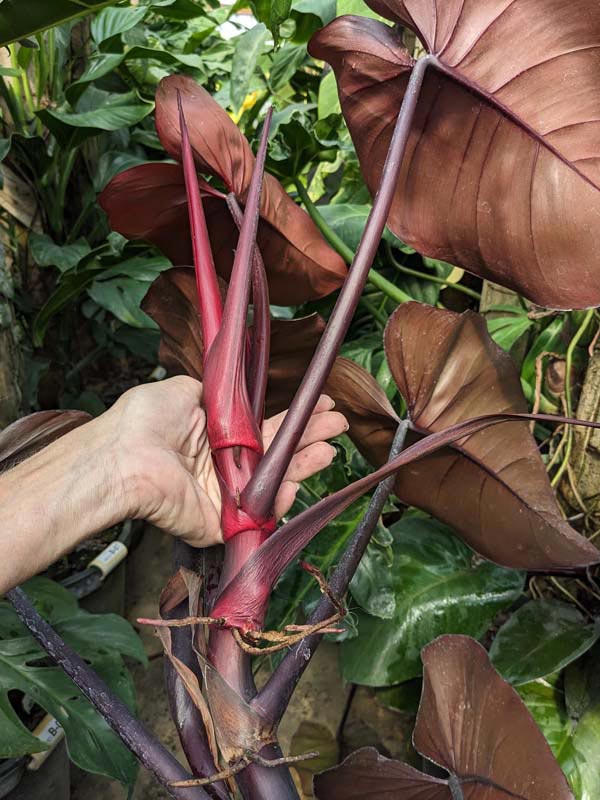The Philodendron Bloody Mary is an impressive houseplant with unique foliage and striking looks. The plant has dark red leaves, which are easy to grow and this is why it’s regarded as one of the best plants by plant lovers. This guide, therefore, provides you with all the information that you will require in properly growing and looking after your Philodendron Bloody Mary regardless of whether you are a novice or a veteran plant lover.
What is Philodendron Bloody Mary?
An Overview
The Araceae family comprises the hybrid Philodendron Bloody Mary. The genus of this hybrid type is known for its wide range of attractive leaf forms. It has gained popularity due to its glossy, dark-red leaves and its relatively low maintenance requirements.
Characteristics
- Leaves: With maturity, heart-shaped leaves will range from deep red to a more subdued maroon colour.
- Growth Habit: It climbs or trails making it suitable for both hanging baskets and climbing supports.
- Size: Indoor grown it reaches around 3-4 feet in height.

Benefits of Growing Philodendron Bloody Mary
Aesthetic Appeal
The bold and vibrant foliage of the Philodendron Bloody Mary adds a splash of color to any indoor space. Its distinctive appearance can fit into different interior design styles hence making it a multi-purpose home decor selection.
Air Purification
Philodendron Bloody Mary like many other indoor plants can improve air quality by removing pollutants within a room as well as increasing humidity levels. For these reasons, it is recommended that you include them in your home setting.
Low Maintenance
In comparison to other houseplants, bloody mary requires less work on your part so that it thrives. This plant grows well in various indoor conditions with little attention from you since they are tough enough for busy people who may not have time to take care of their plants consistently.
How to Grow Philodendron Bloody Mary
Choosing the Right Location
Philodendron Bloody Mary thrives in bright, indirect light. Place it next to a window that has been tinted as direct sunlight can cause scorching of its leaves. Slow growth may occur but it can tolerate lower lighting conditions.
Potting and Soil
Potting: To avoid water logging, use a pot that has holes for draining. The root system of the plant should not be confined in an extremely large container though.
Soil: A well-draining potting mix is important. Peat, perlite and pine bark mixture does well. The soil should be consistently moist but not soggy.
Watering
In case you notice that the top inch of soil is dry, consider watering your Philodendron Bloody Mary. This will prevent root rot because watering should only be done when the soil has dried up completely between waterings. The plant growth rate decreases during winter months; therefore reduce watering.
Fertilizing
Bloody Mary plants are fed with balanced liquid fertilizers every 4-6 weeks during their growing season (spring and summer). Do not overfertilize so as to prevent salt accumulation within the plant which could lead to damage.
Pruning
Regularly pruning helps keep a desired shape of your plant as well as promoting bushier growths. Therefore, discard those leaves which have already died or are turning yellowish while cutting off spindly stems will encourage new growths to grow on these plants.
Philodendron Bloody Mary Care
Humidity
Higher humidity is preferred by Philodendron Bloody Mary’s houseplants. In case you stay in an area where there is low moisture content in the air inside your house then use a humidity tray or room humidifier for maintaining an ideal environment for your plant.
Temperature
Temperatures ranging from 65°F to 80°F (18°C to 27°C) are best suited for this plant. Keep it away from drafts and sudden changes in temperatures will be hazardous to the bloody mary.
Troubleshooting and Common Problems
Root Rot
- Symptoms: Leaves that are drooping, turning yellow and have a slushy root system.
- Solution: Ensure there are holes in the potting container and avoid too much watering. Remove affected roots and transplant the plant into fresh soil that drains well if the problem is severe.
Leggy Growth
- Symptoms: Stems become elongated with few leaves present.
- Solution: To make it bushier, increase exposures to light. Prune leggy stems to encourage new, denser growth.
Leaf Curling
- Symptoms: Leaves curl or distort in shape.
- Solution: Leaf curl may result from inconsistent watering, low humidity or drafts. Maintain regular watering and increase humidity when required.
Propagation of Philodendron Bloody Mary
Methods
- Stem Cuttings: The most popular method of propagation involves taking a 4-6 inch cutting from a healthy mother plant; ensuring it has several nodes. Put the cutting into water or a moist potting mix until it develops roots.
- Division: This is done by separating the plant into several sections each with its root system during repotting time usually done during repotting events.
Steps for Successful Propagation
- Prepare Cuttings: Use sterile knife or scissors to take cuttings. Trim off excess leaves then dip the cut ends into rooting hormone;
- Planting : Place them into water or a pot containing moistened planting mix so as to have nodes submerged within soil;
- Care : Keep cuttings in a warm humid environment until they develop roots then transplant them into individual pots;

Philodendron Bloody Mary vs. Bloody Mary Philodendron
Differences
Though interchangeable these names mostly indicate one single species known as “Bloody mary”. But still you need to cross check specifically for variety and qualities by referring back to your source before buying it;
Similarities
Both terms describe the same tropical plant which has bold foliage and requires low maintenance. The only thing you need to do is to understand the specific care a given plant requires in order for it to thrive;
Mature Philodendron Bloody Mary
Growth
As the plant grows, the leaves may become larger and darker. It also has increased growth rate, greater root system.
Care for Mature Plants
Continue providing appropriate light, water and nutrients; and as they grow bigger repotting may be done more often because of their developing root systems.
Philodendron Bloody Mary for Different Environments
Apartment Living
Due to its small size and need for low light Philodendron Bloody Mary would make an excellent apartment plant. It can do well even in limited spaces while bringing greenness into your indoor environment.
Office Spaces
Bloody Marys are perfect plants for offices because they purify air with minimal efforts required on their maintenance. They improve air quality without demanding much attention from workers hence making them prefer working within environments where they are grown.
Homes with Pets
If you have pets, ensure the plant is placed out of their reach. While Philodendrons are not highly toxic, ingestion can cause mild gastrointestinal upset in pets. Keeping the plant safe eliminates all potential issues it could bring about especially if consumed by animals around it;
Propagation Tips and Techniques
Water Propagation
Steps:
- Take a 4-6 inch cutting from a healthy plant including a node.
- Put that cutting into a jar of water so that the node is under water.
- Change the water every few days looking out for root development.
- Transplant cutting once roots have reached 2-3 inches long.
Soil Propagation
Steps:
- Take a cutting of 4 to 6 inches and remove extra leaves.
- If necessary, soak the cut end in rooting hormone.
- Plant it on a pot containing moist soil that drains well.
- Maintain humidity by covering it with plastic bag or dome until roots develop.
Tips for Success
- A successful rooting requires one node at least on the cutting.
- Warm and humid conditions favor root growth in cuttings being propagated newly.
- To avoid stress, keep the sun off newly planted cuttings grown under direct sunlight.
Philodendron Bloody Mary in Different Seasons
Spring and Summer
During the growing season, Philodendron Bloody Mary exhibits vigorous growth. This necessitates more watering as well as fertilization to support such growth. It also provides an opportunity for propagation or repotting if required by this time of year.
Fall and Winter
Watering should be reduced during these cold months as plant’s growth drops. Close all areas of exposure to drafts from cold winds around. Daylight hours are shorter now so maintain enough light supply.

Enhancing Your Philodendron Bloody Mary Display
Pot and Planter Options
Choose attractive pots that blend with your home interior design. Decorative pots add beauty to plants. Look into self-watering options to make maintenance easier.
Support Structures
For support structures, use stakes or trellises when you want climbing or trailing growth. Here is where the plant grows upwards into dimensions other than height only but also outwardly away from its main body mass resulting into further dimensional complexity hence higher aesthetic value of the display area too.
Combining Plants
Other houseplants can be grown together alongside Philodendron Bloody Mary in mixed planter arrangement; it matches perfectly with them. Combining different heights of plants having diverse textures transforms your indoor garden into an engaging environment.
FAQs About Philodendron Bloody Mary
What is the best lighting for Philodendron Bloody Mary?
It flourishes under bright light which is not direct. Direct sunlight destroys the leaves of this plant thereby causing scorching on them; in case you have limited access to natural light, do use growing lights.
How often should I repot my Philodendron Bloody Mary?
Generally, it needs to be repotted after every 1-2 years or when the current pot becomes too small for it. It is time to change the pot if roots start coming out through drainage holes and their growth has slowed down; also, water remains above ground level
Can Philodendron Bloody Mary be grown outdoors?
Though outdoor planting in tropical and subtropical zones is possible for Philodendron Bloody Mary, it is mostly an indoor plant in moderate climate areas. In these suitable regions, keep it away from extreme sun; full shade and high levels of humidity need to be provided.
How do I handle yellowing leaves on my Philodendron Bloody Mary?
The causes of yellowing are overwatering, poor drainage and inadequate lighting. Always check moisture content in soil then adjust watering schedule accordingly. Confirm that your plants receive enough light while they are also able to drain water properly when holes are big enough.
What pests commonly attack Philodendron Bloody Mary?
Mealybugs, spider mites and aphids are common pests that can invade your philandering creatures called “Bloody mary”(plural). If you spot any signs of infestation, promptly treat with insecticidal soap or neem oil among other appropriate methods.
Final Words
Growing a Philodendron Bloody Mary can transform your indoor space with its striking foliage and low-maintenance care. Understanding its specific requirements as well as addressing any impending problems allows you to enjoy healthy lively surroundings within the house with well-developed plants like these ones that eventually add value to our homes.”
This guide is a must-have for every beginner or experienced planter who wants to grow and care for their Philodendron Bloody Mary successfully. It is a beautiful and useful plant that you can have in your house as part of indoor gardening.
